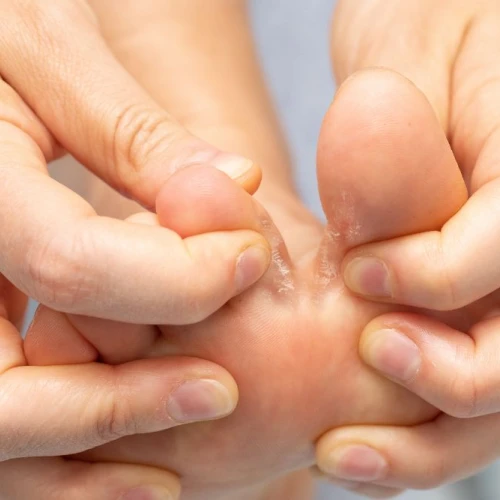What is athlete's foot?1, 2
Athlete’s foot is a very common condition caused by dermatophyte mycosis (a type of microscopic fungus) affecting the spaces between the small toes. It occurs most often between the 4th and 5th toe. The fungus responsible for most cases of athlete’s foot is trichophyton rubrum.
Tinea pedis is spread by direct or indirect contact (the most common method of transmission) with the fungus, skin flakes or lesions.
Symptoms: how do you know if you have athlete's foot?1, 2, 3
The bottom of the crease between two toes is cracked and presents a slight dry or oozing desquamation (peeling skin). The area may be red or white, painful and itchy in most cases. The flaky skin can affect only the crease and the toes concerned or the entire sole of the foot. Nails can be infected but this is much rarer.
Initially, the athlete’s foot may only affect a single foot, but it can also affect both feet through self-spreading.
The peeling skin (desquamation) can sometimes be so severe that it causes the skin to crack painfully, leading to fissures. In some cases, blisters can form at the location of the fungal infection. If the fungal infection affects the entire sole of the foot (in the most severe cases), the skin can thicken and crack. The cracking then increases the risk of bacterial superinfection, the most common complication of athlete’s foot. This is particularly the case in the elderly, in people with reduced blood flow to the feet (diabetic patients), people with immunodeficiency disorders, liver inflammation and chemotherapy patients.
What are the causes of athlete’s foot?3, 4
Having sweaty feet favours the development of Athlete's foot. Accumulated moisture in the warm area between the toes is conducive to the proliferation of fungi. The fungi is highly contagious and can spread from person to person in public swimming pools (communal pools and showers) but also in other hot and humid places where infected people walk barefoot (spas).
The risk factors for athlete’s foot are:
- Wearing narrow shoes, as feet sweat more in this type of footwear;
- Excessively sweaty feet;
- Poor foot hygiene;
- Not drying your feet properly after a shower, bath or swwww.excilor.com/en-gb/bolt/edi...#" class="redactor-autoparser-object">https://dev.<a href="..." class="redactor-autoparser-object">www.excilor.com/en...im (moisture collects between the toes);
- Sharing infected personal effects (bath towels, socks, pool sliders, etc.);
- Walking barefoot in infected areas.
Treatment: how do you get rid of athlete's foot?3
Athlete’s foot is generally treated with antifungal products (creams, sprays, powders) that are applied directly to the area concerned. This is generally all that it takes to stop the fungi from spreading in just a few days. These products are available as over-the-counter products. They should be used for one to two weeks after the infection to prevent any recurrence.
However, if the infection returns, which is often the case with athlete’s foot, or if it gets worse*, see a doctor. When athlete's foot has been diagnosed by a clinical examination of the feet and, if necessary, a skin scraping, the doctor may prescribe antifungal topical or oral medication, or both at the same time.
*Signs of worsening infection include swelling of the foot, which is warm to the touch, the appearance of red lines, the presence of pus and a temperature.
How do you prevent athlete’s foot?2, 3, 5
The best way to prevent athlete's foot is to limit the amount of moisture on your feet and in your shoes, and not coming into direct contact with an infected surface. For this, it is recommended that you:
- Wear open or “breathable” shoes, and change your socks frequently, especially in hot weather.
- Do not wear shoes that are too tight or socks and made out of synthetic material (e.g. nylon) that prevent sweat from escaping.
- Dry the space between the toes thoroughly after a bath, shower or swimming.
- Apply absorbent antifungal powder if you have very sweaty feet.
- Wear sandals in public showers and changing rooms or around swimming pools to avoid coming into direct contact with potentially infected areas.


